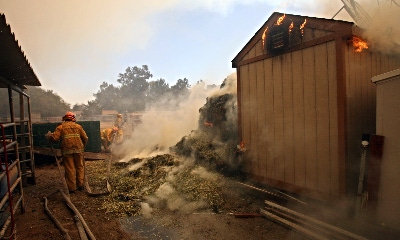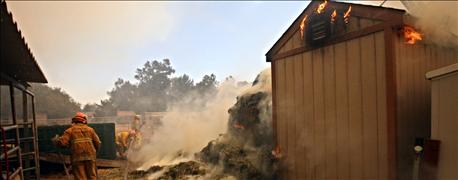
Putting up wet hay can create problems in the barn due to hay fires. This year farmers need to pay special attention to hay harvesting conditions to prevent costly fires.
Proper harvesting and storage practices will reduce the possibility of hay fires, according to Bob Schultheis, a natural resource engineering specialist with University of Missouri Extension. Schultheis shares that hay fires can create additional costs for farmers in terms of replacing a storage facility and feed.
Here are three ways that farmers can reduce their risk of hay fires:

BE PREPARED: Barn fires from hay put up in wet conditions can cause not only loss of feed, but also building damage. Make sure conditions are right during hay harvest. Then monitor hay storage facilities. (Photo courtesy Getty Images)
1. Bale at the correct moisture content. "You can reduce fire and mold risk by baling small square bales at 18 to 22% moisture content," Schultheis says. Because large round bales contain three times more hay per square foot of surface area, it takes longer for the bales to give up their moisture, so they need to be baled drier at 14% to 18% moisture content. Anything above the 20% moisture range, can increase the amount of mold growth on hay. This increase in mold along with the amount of hay itself, increases the amount of respiration done by the hay bales. A major product of respiration is heat. The moisture content of a hay bale accounts for a lot of the risk of hay fires. "Higher moisture levels increase microbial activity and result in loss of dry matter and usable protein, which can reduce the feeding value of the hay by as much as one-third," Schultheis adds.
2. Monitor bale heat regularly. Safe storage temperature for hay is 120 degrees F or less. Any hay that’s moisture level content is questionable, should be monitored regular for increases in temperature. The range for which action can be taken is in between 120 degrees and 140 degrees F. If hay bales are in this temperature range, they should be given space to allow air circulation. Hay temperature can be easily checked using a composting thermometer. A probe can also be built using a 3/8-inch diameter pipe with a pointed tip screwed to the end and holes drilled in it. A thermometer can then be inserted into the pipe and retrieved and read after 10 to 15 minutes. A good reason for watching the temperature is that if hay reaches over 150 degrees F, not much can be done for the bales. If this temperature is exceeded, the fire department should be called and the hay bales should be left in place. Do not open the barn door if hay bales are smoking, as this will cause the bales to burst into flame.
3. Bale hay in the right conditions. Hay fires usually occur within six weeks of baling, with excessive moisture being a main cause. Not giving enough time for the hay to dry out is a major problem. Heating in hay bales will occur to some extent in all forages over 15% moisture content, with a peak in temperature four to seven days after baling according to Schultheis.
In a video that has been circulating since 2009, Daren Redfearn talked about the proper time to bale hay when he was at Oklahoma State University. “High temperatures, a little bit of breeze, low humidity are going to be ideal [conditions] for rapidly drying out that hay,” Redfearn explained. Baling hay at the proper conditions will allow for the decrease of moisture left in the bale, reducing the risk of hay fires.
Proper monitoring and prior planning can significantly reduce the risk of hay fires. Hay fires can destroy buildings and the land around them and cost you a lot of money. Remembering these three tips can helps you prevent hay fires.
About the Author(s)
You May Also Like






